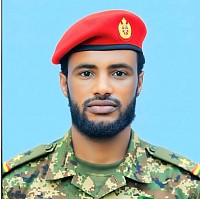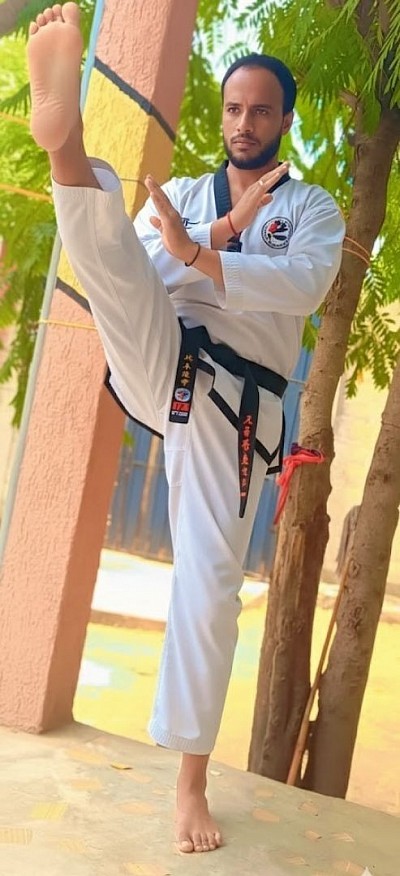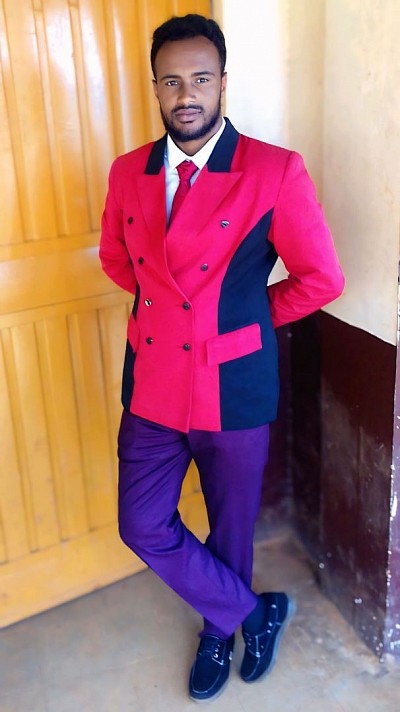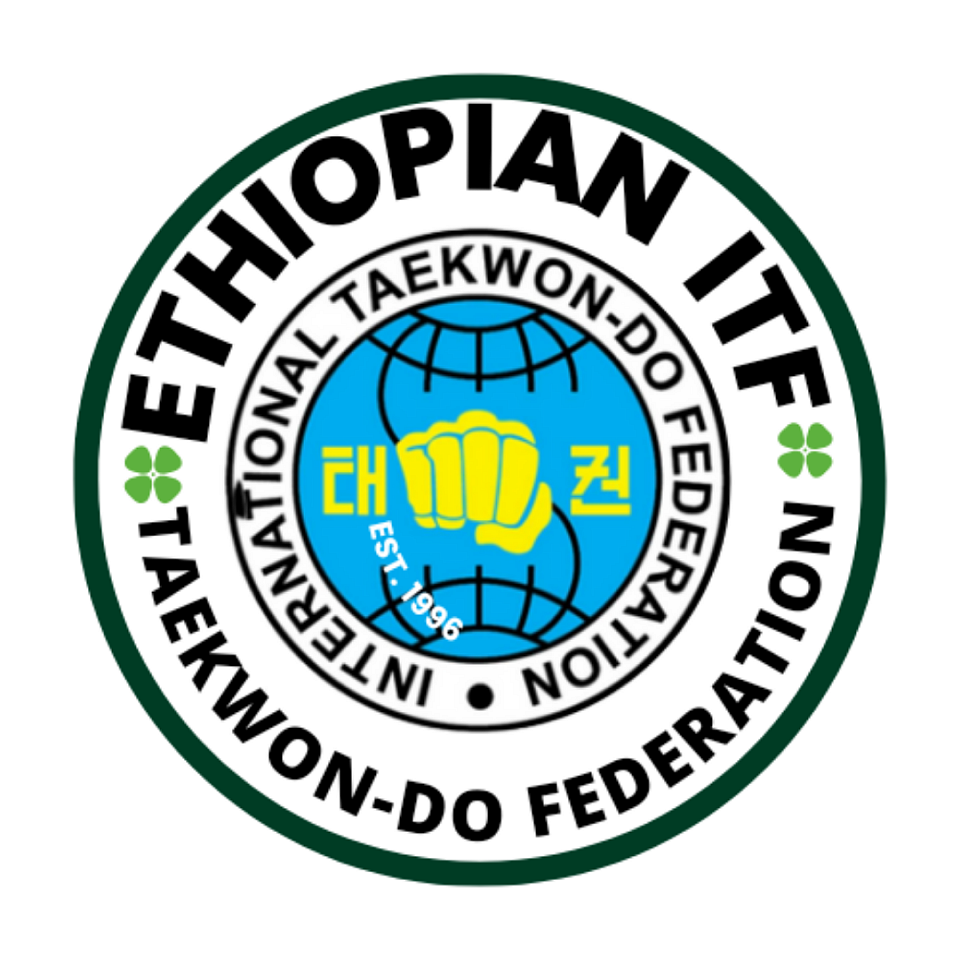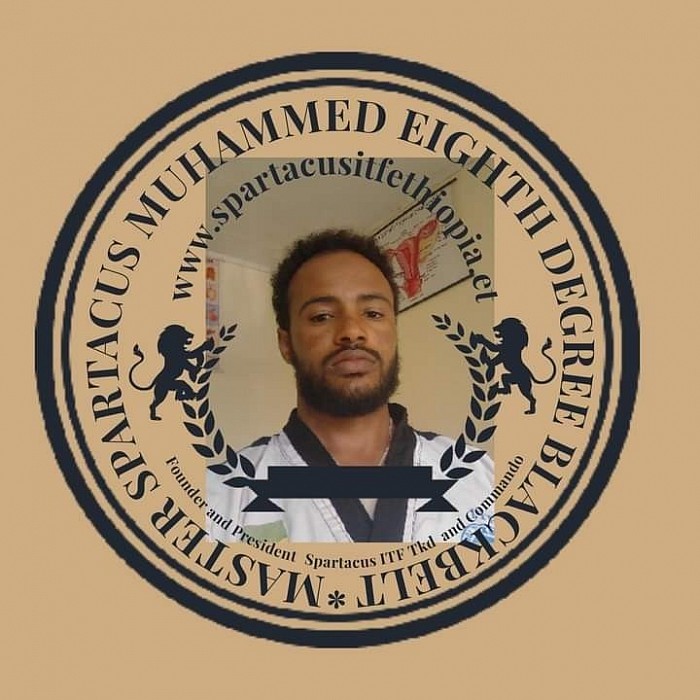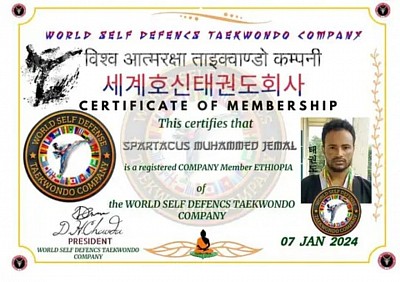PRESIDENT OF SPARTACUS ITF TAEKWON-DO IN AFRICA ®️🌎
History of general Choi hong hi
Dear Members,
I, on behalf of the Spartacus International Taekwon‑Do Assocition (SITA), would like to extend my heartfelt thanks and congratulations to all the Taekwon‑Doists the world over who have been devoting themselves to the worldwide development and evolution of the original Taekwon‑Do, the legacy of the late Gen. Choi Hong Hi, the Legendary Founder of Taekwon‑Do and 1st ITF President.
Availing myself of this opportunity, I would as well like to express my thanks and appreciations to those who have been paying great attention to the strengthening of ITF and even today rendering every possible support and contribution to the growing-up of ITF throughout the world even though they are not being involved in the physical training of Taekwon‑Do.
In recent, Taekwon‑Do is certainly consolidated its position as one of a world-renowned martial arts, thanks to the tireless efforts and dedications of all Taekwon‑Do brothers and sisters across the world as well as its lovers, which is greatly conducive to making this planet more harmonious with disregards to the race, religion and color of skins in keeping with the initial ideals and goals of the original Taekwon‑Do.
The legendary Founder Gen. Choi Hong Hi has always been stressing to the practitioners during his lifetime that there would be nothing to scare the peoples who are moving forward with the indomitable spirits and strong sense of challenges, consequently, the Instructors teaching the classes every day in every corner of this globe are regarded a very, very important person as they are virtually responsible for the education, particularly for the moral education on the practitioners.
Therefore, we, SITF, are about to focus on the improvement of the skills and capabilities of the Instructors as a Teacher in the future and thus, inspire them to play a due role in teaching the students to get ready not only physically but morally as having desired by our Father Gen. Choi Hong Hi.
For this purpose, I sincerely wish to hear the constructive opinions and counsels from our members as well as to encourage all the Instructors over the world through this chance to exchange the experiences and lessons you gained from running the classes till now among yourselves.
What is the most important thing is that we must, in any case, respect our Seniors as the Martial-Artists.
Without this discipline and principle, we are not able to stand firmly on the right path to build a moral and better society in accordance with the Charter of Taekwon‑Do and it would finally destroy ourselves.
It is a well-known secret that there will be a lot of challenges and difficulties ahead of us, however, if we work together, we have nothing to fear.
Please keep in mind that the way of working together leads us into the future, therefore, may I take this opportunity to appeal to you all “Let us unite more firmly and work together in any case as the disciples of Gen. Choi Hong Hi.”
Looking forward to your sincere and fervent supports and cooperation with SITA in the future and wishing you all the very best and good health.
Thank you.
Master Spartacus Muhammed Jemal’s journey to becoming a military commando is one of dedication, discipline, and unwavering commitment. Here are the key steps that led him to this esteemed position:
Physical Fitness and Training: Spartacus began by honing his physical fitness and endurance. He engaged in rigorous exercises, strength training, and cardiovascular workouts to build the stamina required for military service.
Education and Military Academy: He pursued education and training at a military academy. This involved learning essential skills such as combat tactics, survival techniques, and weapons handling. His determination and performance during training caught the attention of his superiors.
Specialization: Spartacus chose to specialize in commando operations. Commandos are elite soldiers trained for covert missions, counter-terrorism, and unconventional warfare. His dedication to mastering these specialized skills set him apart.
Combat Experience: Spartacus gained practical experience through military deployments and combat situations. His ability to remain calm under pressure, adapt to changing circumstances, and make split-second decisions contributed to his success.
Leadership and Teamwork: As he progressed, Spartacus demonstrated leadership qualities and the ability to work effectively within a team. Commandos rely on each other, and his teamwork skills were crucial.
Selection Process: Becoming a commando involves a rigorous selection process. Spartacus underwent physical and mental assessments, including obstacle courses, endurance tests, and interviews. His determination and performance secured his place.
Advanced Training: After selection, he underwent advanced training specific to commando operations. This included specialized weapons training, close-quarters combat, and survival techniques.
Operational Deployments: Spartacus participated in real-world operations, putting his training to the test. His successful missions further solidified his position as a skilled and reliable commando.
Continuous Learning: Commandos continually update their skills. Spartacus attended workshops, seminars, and further training to stay at the forefront of military tactics and technology.
Leadership Roles: Over time, he assumed leadership roles within the commando unit. His ability to lead by example, inspire others, and make strategic decisions contributed to his rise.
Today, Master Spartacus Muhammed Jemal stands as a respected military commando, embodying courage, discipline, and unwavering commitment to duty. 🇪🇹💪🏽
Master Spartacus Muhammed Jemal is a remarkable figure in the world of martial arts and military commando training. Let’s delve into his background and accomplishments:
Military Commando and Martial Arts Instructor: Master Spartacus Muhammed Jemal serves as a Military Commando in the African Air Force’s special commando unit. His expertise extends to both military operations and martial arts training123.ITF Taekwondo: He is an 8th Dan master in the International Taekwon-Do Federation (ITF) and a member of various ITF federations, including ICTF, ITF MDK, WWMAA, ITF UK, ITF US, ITF Korea, and unified ITF. Additionally, he founded the Spartacus ITF and Commando Association (SITCA) in Ethiopia45.
Master Spartacus Muhammed Jemal’s impact extends beyond Ethiopia, making him a notable figure in both martial arts and military circles. 🥋🔥
Master Spartacus Muhammed Jemal’s journey to becoming a military commando was a rigorous and time-intensive process. While the exact duration can vary based on individual circumstances, here’s a general outline of the steps involved:
Basic Military Training: Initially, Spartacus would have undergone basic military training, which typically lasts several months. This training covers fundamental skills such as physical fitness, discipline, and teamwork.
Specialized Training: After basic training, he would have transitioned to specialized training. Becoming a commando involves additional months (or even years) of intense training. This includes learning combat tactics, survival skills, and mastering weapons.
Selection Process: The selection process for commandos is demanding. Spartacus would have participated in assessments, obstacle courses, and interviews. This phase can take several weeks to months.
Operational Experience: Spartacus gained practical experience through operational deployments. This phase could span several years, during which he participated in real-world missions, honing his skills and proving his capabilities.
Leadership Roles: As he progressed, Spartacus likely assumed leadership roles within the commando unit. Leadership development takes time, and he would have demonstrated competence and reliability.
Continuous Learning: Commandos continually update their skills. Spartacus would have attended workshops, seminars, and further training throughout his career.
Considering all these factors, it’s safe to say that Spartacus Muhammed Jemal’s journey to becoming a military commando likely spanned several years. His dedication, perseverance, and commitment were essential in achieving this esteemed position. 🇪🇹💪🏽
Commandos are highly trained and specialized military units that undertake a variety of critical missions. Their tasks can vary based on the specific unit, country, and operational context. Here are some common types of missions that commandos may be involved in:
Direct Action (DA):
Commandos engage in direct combat against enemy forces. These missions involve raids, ambushes, and targeted strikes.Examples: Hostage rescue, targeted assassinations, and sabotage operations.
Counter-Terrorism:
Commandos respond swiftly to terrorist threats. They neutralize terrorists, secure hostages, and prevent attacks.Examples: Storming hijacked planes, rescuing hostages from buildings, and eliminating terrorist cells.
Reconnaissance and Intelligence Gathering:
Commandos gather critical information behind enemy lines. They assess terrain, enemy positions, and infrastructure.Examples: Long-range patrols, infiltration missions, and surveillance.
Unconventional Warfare (UW):
Commandos support resistance movements or indigenous forces in occupied territories.Examples: Training local fighters, supplying weapons, and conducting guerrilla warfare.
Counter-Insurgency (COIN):
Commandos combat insurgent groups within their own country or in foreign conflicts.Examples: Clearing rebel-held areas, disrupting supply lines, and winning hearts and minds.
Special Reconnaissance (SR):
Commandos gather intelligence on high-value targets, enemy installations, or sensitive areas.Examples: Infiltrating enemy bases, identifying key personnel, and assessing threats.
Search and Rescue (SAR):
Commandos locate and extract downed pilots, stranded soldiers, or civilians in distress.Examples: Rescuing pilots behind enemy lines, evacuating disaster victims, and saving hostages.
Covert Operations:
Commandos operate clandestinely, often without official acknowledgment.Examples: Espionage, assassinations, and disrupting enemy communications.
Counter-Narcotics and Maritime Interdiction:
Commandos combat drug trafficking, piracy, and smuggling.Examples: Boarding suspect vessels, seizing drug shipments, and interdicting pirates.
Training and Advising:
Commandos train foreign military units or indigenous forces.Examples: Teaching combat skills, improving tactics, and enhancing capabilities.
Remember that commandos operate in high-risk environments, often with limited resources and under extreme conditions. Their adaptability, courage, and specialized training make them indispensable assets in modern warfare. 🇪🇹💪🏽
The training for commandos is exceptionally grueling. It pushes individuals to their limits and beyond. Here are some aspects of the physically demanding training that aspiring commandos undergo:
Endurance and Stamina:
Commandos must build exceptional endurance. They endure long marches, obstacle courses, and extended missions.Running, swimming, and rucking (carrying heavy loads) are integral parts of their training.
Strength and Conditioning:
Commandos focus on functional strength. They perform bodyweight exercises, weightlifting, and calisthenics.Core strength is crucial for stability during combat and challenging situations.
Obstacle Courses:
Commandos navigate intricate obstacle courses that simulate real-world scenarios.These courses include climbing walls, crawling under barbed wire, and jumping over obstacles.
Combat Drills:
They practice combat movements repeatedly until they become second nature.Fire and movement, room clearing, and reacting to ambushes are part of these drills.
High-Intensity Training:
Commandos engage in high-intensity interval training (HIIT) to simulate combat stress.This includes rapid sprints, quick changes of direction, and intense bursts of activity.
Waterborne Training:
Commandos learn to operate in water environments.Swimming, diving, and waterborne infiltration are essential skills.
Unconventional Terrain Training:
They train in diverse environments: jungles, deserts, mountains, and urban areas.Each terrain presents unique challenges.
Weapon Handling and Marksmanship:
Commandos become proficient with various weapons.Rifles, pistols, and machine guns are part of their arsenal.
Mental Toughness:
Physical training is intertwined with mental resilience.Commandos learn to push through pain, exhaustion, and discomfort.
Teamwork and Leadership:
They train as a team, relying on each other.Leadership skills are honed through practical exercises.
Simulated Combat Scenarios:
Commandos participate in realistic scenarios.These include live-fire exercises, night operations, and stress-induced drills.
Recovery and Adaptation:
Recovery is crucial. Commandos learn to manage fatigue and prevent injuries.They adapt to changing conditions and remain mission-ready.
In summary, commando training is physically demanding, but it also builds mental resilience, teamwork, and adaptability. Those who complete it emerge as elite warriors capable of handling the toughest challenges. 💪🏽🔥
Trainmasters
Star
Master Spartacus Muhammed Jemal’s journey to becoming a military commando is one of dedication, discipline, and unwavering commitment. Here are the key steps that led him to this esteemed position:
Physical Fitness and Training: Spartacus began by honing his physical fitness and endurance. He engaged in rigorous exercises, strength training, and cardiovascular workouts to build the stamina required for military service.
Education and Military Academy: He pursued education and training at a military academy. This involved learning essential skills such as combat tactics, survival techniques, and weapons handling. His determination and performance during training caught the attention of his superiors.
Specialization: Spartacus chose to specialize in commando operations. Commandos are elite soldiers trained for covert missions, counter-terrorism, and unconventional warfare. His dedication to mastering these specialized skills set him apart.
Combat Experience: Spartacus gained practical experience through military deployments and combat situations. His ability to remain calm under pressure, adapt to changing circumstances, and make split-second decisions contributed to his success.
Leadership and Teamwork: As he progressed, Spartacus demonstrated leadership qualities and the ability to work effectively within a team. Commandos rely on each other, and his teamwork skills were crucial.
Selection Process: Becoming a commando involves a rigorous selection process. Spartacus underwent physical and mental assessments, including obstacle courses, endurance tests, and interviews. His determination and performance secured his place.
Advanced Training: After selection, he underwent advanced training specific to commando operations. This included specialized weapons training, close-quarters combat, and survival techniques.
Operational Deployments: Spartacus participated in real-world operations, putting his training to the test. His successful missions further solidified his position as a skilled and reliable commando.
Continuous Learning: Commandos continually update their skills. Spartacus attended workshops, seminars, and further training to stay at the forefront of military tactics and technology.
Leadership Roles: Over time, he assumed leadership roles within the commando unit. His ability to lead by example, inspire others, and make strategic decisions contributed to his rise.
Today, Master Spartacus Muhammed Jemal stands as a respected military commando, embodying courage, discipline, and unwavering commitment to duty. 🇪🇹💪🏽
Master Spartacus Muhammed Jemal is a remarkable figure in the world of martial arts and military commando training. Let’s delve into his background and accomplishments:
Military Commando and Martial Arts Instructor: Master Spartacus Muhammed Jemal serves as a Military Commando in the African Air Force’s special commando unit. His expertise extends to both military operations and martial arts training123.ITF Taekwondo: He is an 8th Dan master in the International Taekwon-Do Federation (ITF) and a member of various ITF federations, including ICTF, ITF MDK, WWMAA, ITF UK, ITF US, ITF Korea, and unified ITF. Additionally, he founded the Spartacus ITF and Commando Association (SITCA) in Ethiopia45.
Master Spartacus Muhammed Jemal’s impact extends beyond Ethiopia, making him a notable figure in both martial arts and military circles. 🥋🔥
Master Spartacus Muhammed Jemal’s journey to becoming a military commando was a rigorous and time-intensive process. While the exact duration can vary based on individual circumstances, here’s a general outline of the steps involved:
Basic Military Training: Initially, Spartacus would have undergone basic military training, which typically lasts several months. This training covers fundamental skills such as physical fitness, discipline, and teamwork.
Specialized Training: After basic training, he would have transitioned to specialized training. Becoming a commando involves additional months (or even years) of intense training. This includes learning combat tactics, survival skills, and mastering weapons.
Selection Process: The selection process for commandos is demanding. Spartacus would have participated in assessments, obstacle courses, and interviews. This phase can take several weeks to months.
Operational Experience: Spartacus gained practical experience through operational deployments. This phase could span several years, during which he participated in real-world missions, honing his skills and proving his capabilities.
Leadership Roles: As he progressed, Spartacus likely assumed leadership roles within the commando unit. Leadership development takes time, and he would have demonstrated competence and reliability.
Continuous Learning: Commandos continually update their skills. Spartacus would have attended workshops, seminars, and further training throughout his career.
Considering all these factors, it’s safe to say that Spartacus Muhammed Jemal’s journey to becoming a military commando likely spanned several years. His dedication, perseverance, and commitment were essential in achieving this esteemed position. 🇪🇹💪🏽
Commandos are highly trained and specialized military units that undertake a variety of critical missions. Their tasks can vary based on the specific unit, country, and operational context. Here are some common types of missions that commandos may be involved in:
Direct Action (DA):
Commandos engage in direct combat against enemy forces. These missions involve raids, ambushes, and targeted strikes.Examples: Hostage rescue, targeted assassinations, and sabotage operations.
Counter-Terrorism:
Commandos respond swiftly to terrorist threats. They neutralize terrorists, secure hostages, and prevent attacks.Examples: Storming hijacked planes, rescuing hostages from buildings, and eliminating terrorist cells.
Reconnaissance and Intelligence Gathering:
Commandos gather critical information behind enemy lines. They assess terrain, enemy positions, and infrastructure.Examples: Long-range patrols, infiltration missions, and surveillance.
Unconventional Warfare (UW):
Commandos support resistance movements or indigenous forces in occupied territories.Examples: Training local fighters, supplying weapons, and conducting guerrilla warfare.
Counter-Insurgency (COIN):
Commandos combat insurgent groups within their own country or in foreign conflicts.Examples: Clearing rebel-held areas, disrupting supply lines, and winning hearts and minds.
Special Reconnaissance (SR):
Commandos gather intelligence on high-value targets, enemy installations, or sensitive areas.Examples: Infiltrating enemy bases, identifying key personnel, and assessing threats.
Search and Rescue (SAR):
Commandos locate and extract downed pilots, stranded soldiers, or civilians in distress.Examples: Rescuing pilots behind enemy lines, evacuating disaster victims, and saving hostages.
Covert Operations:
Commandos operate clandestinely, often without official acknowledgment.Examples: Espionage, assassinations, and disrupting enemy communications.
Counter-Narcotics and Maritime Interdiction:
Commandos combat drug trafficking, piracy, and smuggling.Examples: Boarding suspect vessels, seizing drug shipments, and interdicting pirates.
Training and Advising:
Commandos train foreign military units or indigenous forces.Examples: Teaching combat skills, improving tactics, and enhancing capabilities.
Remember that commandos operate in high-risk environments, often with limited resources and under extreme conditions. Their adaptability, courage, and specialized training make them indispensable assets in modern warfare. 🇪🇹💪🏽
The training for commandos is exceptionally grueling. It pushes individuals to their limits and beyond. Here are some aspects of the physically demanding training that aspiring commandos undergo:
Endurance and Stamina:
Commandos must build exceptional endurance. They endure long marches, obstacle courses, and extended missions.Running, swimming, and rucking (carrying heavy loads) are integral parts of their training.
Strength and Conditioning:
Commandos focus on functional strength. They perform bodyweight exercises, weightlifting, and calisthenics.Core strength is crucial for stability during combat and challenging situations.
Obstacle Courses:
Commandos navigate intricate obstacle courses that simulate real-world scenarios.These courses include climbing walls, crawling under barbed wire, and jumping over obstacles.
Combat Drills:
They practice combat movements repeatedly until they become second nature.Fire and movement, room clearing, and reacting to ambushes are part of these drills.
High-Intensity Training:
Commandos engage in high-intensity interval training (HIIT) to simulate combat stress.This includes rapid sprints, quick changes of direction, and intense bursts of activity.
Waterborne Training:
Commandos learn to operate in water environments.Swimming, diving, and waterborne infiltration are essential skills.
Unconventional Terrain Training:
They train in diverse environments: jungles, deserts, mountains, and urban areas.Each terrain presents unique challenges.
Weapon Handling and Marksmanship:
Commandos become proficient with various weapons.Rifles, pistols, and machine guns are part of their arsenal.
Mental Toughness:
Physical training is intertwined with mental resilience.Commandos learn to push through pain, exhaustion, and discomfort.
Teamwork and Leadership:
They train as a team, relying on each other.Leadership skills are honed through practical exercises.
Simulated Combat Scenarios:
Commandos participate in realistic scenarios.These include live-fire exercises, night operations, and stress-induced drills.
Recovery and Adaptation:
Recovery is crucial. Commandos learn to manage fatigue and prevent injuries.They adapt to changing conditions and remain mission-ready.
In summary, commando training is physically demanding, but it also builds mental resilience, teamwork, and adaptability. Those who complete it emerge as elite warriors capable of handling the toughest challenges. 💪🏽🔥
YOUNGEST ITF MASTER
वर्ल्ड सेल्फ डिफेंस ताइक्वांडो कंपनी इथियोपिया देश में आपका स्वागत करती है। आप अपने देश में वर्ल्ड सेल्फ डिफेंस ताइक्वांडो कंपनी का प्रतिनिधित्व करेंगे और आगामी चैंपियनशिप में अपनी टीम के साथ आएंगे। World Self Defense Taekwondo Company welcomes you to the country of ETHIOPIA You will represent the World Self Defense Taekwondo Company in your country and you will come with your team in the upcoming championship. I, Deepak Chavda, President of World Self Defense Taekwondo Company, welcome you.
